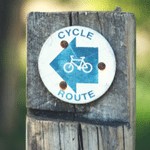BC Healthy Communities is beyond delighted to share some exciting news for anyone who’s been daydreaming about hitting the open road on two wheels. Until February 9, the BikeBC program is accepting applications from communities seeking funding to support cycling infrastructure projects. To date, there are over 100 examples of provincially funded projects throughout BC, and specific grants for smaller communities with a population under 15,000.
The BikeBC program has long been the squeaky spoke for TranBC (Ministry of Transportation and Infrastructure) advocating for cyclists and ongoing improvements to cycling infrastructure across the province. Their aim is to promote alternative transit, reducing traffic congestion and cities’ carbon footprints. By increasing cycling accessibility and safety, bikes are gaining momentum as the preferred choice for commuters traveling to work, school or other amenities. The growth in popularity for bike lanes, cyclist overpasses, and shared multi-use pathways is even promoting an increase in tourism and inter-community closeness.
Not that we mean to pump our own tires, but with four out of 10 of the top cycling neighbourhoods in Canada landing in BC it seems that these projects are pedaling forward with promise. These top 10 neighbourhoods all have a number of things in common. Beyond all of them having at least 15% of commuting trips done by bicycle, they share a number of urban form qualities that provide a foundation for allowing cycling to flourish as a useful mode of transportation for the average person. According to a recent ranking by City Clock Magazine, decoding the November 2017 Canadian Census Transportation Data showcases a win in the uphill climb for cycle-positive neighbourhoods. City Clock depicts four key qualities considered when ranking a neighbourhood’s bike-friendliness. Obviously, the percentage of commuting trips completed by bike is a main factor. However, the proximity of bike routes to useful things is also a big consideration. They also take into account the quality of the cycling network (a grid formation that allows for efficient and direct transit is ideal) and accessibility to back-up transportation, such as bus routes or shared bike stations.
For more information on how to apply for a cycling infrastructure funding, visit the BCBike program page here. We know designing these projects isn’t always smooth, downhill sailing, so take a look at actions you can take to improve active transportation or check out some examples of what other communities are doing to improve biking infrastructure in their communities.
Resources:
– PlanH Active Transportation Site
– Bowen Island’s Plan to increase Active Transportation
– Campbell River’s Sustainability Plan
– Enderby and Splatsan with one Transportation Vision




